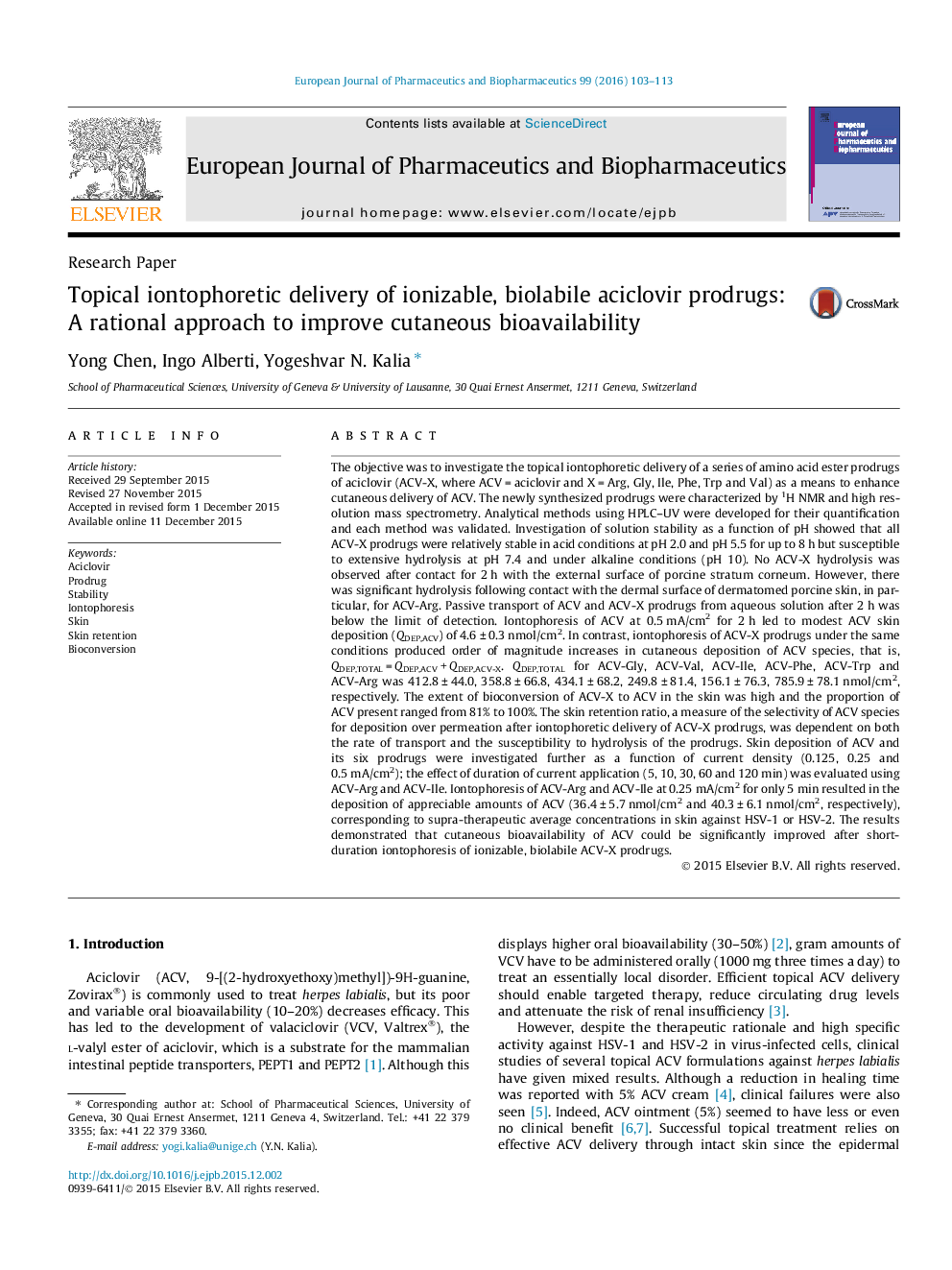| کد مقاله | کد نشریه | سال انتشار | مقاله انگلیسی | نسخه تمام متن |
|---|---|---|---|---|
| 2083395 | 1545324 | 2016 | 11 صفحه PDF | دانلود رایگان |
The objective was to investigate the topical iontophoretic delivery of a series of amino acid ester prodrugs of aciclovir (ACV-X, where ACV = aciclovir and X = Arg, Gly, Ile, Phe, Trp and Val) as a means to enhance cutaneous delivery of ACV. The newly synthesized prodrugs were characterized by 1H NMR and high resolution mass spectrometry. Analytical methods using HPLC–UV were developed for their quantification and each method was validated. Investigation of solution stability as a function of pH showed that all ACV-X prodrugs were relatively stable in acid conditions at pH 2.0 and pH 5.5 for up to 8 h but susceptible to extensive hydrolysis at pH 7.4 and under alkaline conditions (pH 10). No ACV-X hydrolysis was observed after contact for 2 h with the external surface of porcine stratum corneum. However, there was significant hydrolysis following contact with the dermal surface of dermatomed porcine skin, in particular, for ACV-Arg. Passive transport of ACV and ACV-X prodrugs from aqueous solution after 2 h was below the limit of detection. Iontophoresis of ACV at 0.5 mA/cm2 for 2 h led to modest ACV skin deposition (QDEP,ACV) of 4.6 ± 0.3 nmol/cm2. In contrast, iontophoresis of ACV-X prodrugs under the same conditions produced order of magnitude increases in cutaneous deposition of ACV species, that is, QDEP,TOTAL = QDEP,ACV + QDEP,ACV-X. QDEP,TOTAL for ACV-Gly, ACV-Val, ACV-Ile, ACV-Phe, ACV-Trp and ACV-Arg was 412.8 ± 44.0, 358.8 ± 66.8, 434.1 ± 68.2, 249.8 ± 81.4, 156.1 ± 76.3, 785.9 ± 78.1 nmol/cm2, respectively. The extent of bioconversion of ACV-X to ACV in the skin was high and the proportion of ACV present ranged from 81% to 100%. The skin retention ratio, a measure of the selectivity of ACV species for deposition over permeation after iontophoretic delivery of ACV-X prodrugs, was dependent on both the rate of transport and the susceptibility to hydrolysis of the prodrugs. Skin deposition of ACV and its six prodrugs were investigated further as a function of current density (0.125, 0.25 and 0.5 mA/cm2); the effect of duration of current application (5, 10, 30, 60 and 120 min) was evaluated using ACV-Arg and ACV-Ile. Iontophoresis of ACV-Arg and ACV-Ile at 0.25 mA/cm2 for only 5 min resulted in the deposition of appreciable amounts of ACV (36.4 ± 5.7 nmol/cm2 and 40.3 ± 6.1 nmol/cm2, respectively), corresponding to supra-therapeutic average concentrations in skin against HSV-1 or HSV-2. The results demonstrated that cutaneous bioavailability of ACV could be significantly improved after short-duration iontophoresis of ionizable, biolabile ACV-X prodrugs.
Figure optionsDownload high-quality image (147 K)Download as PowerPoint slide
Journal: European Journal of Pharmaceutics and Biopharmaceutics - Volume 99, February 2016, Pages 103–113
